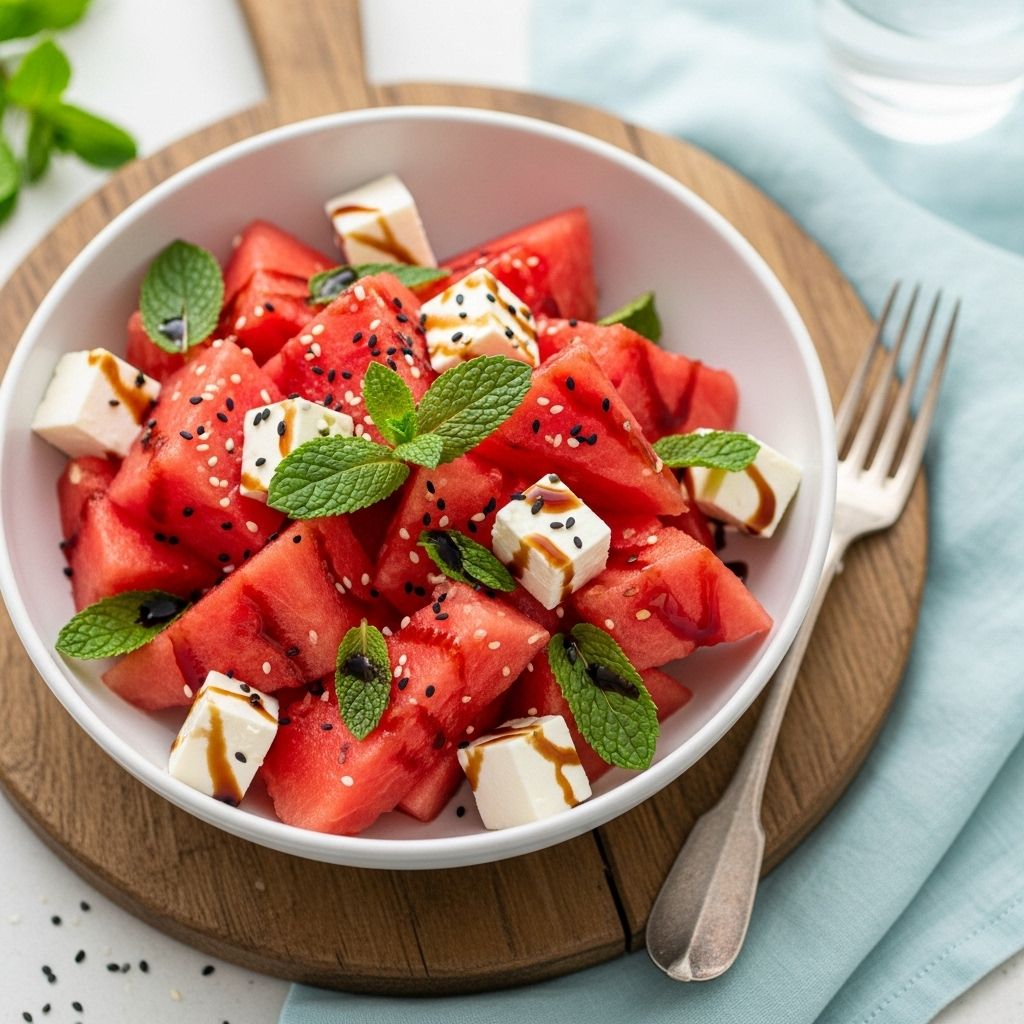Watermelon, Feta, And Mint Salad: 5 Tips For Perfect Balance
Summer freshness meets exact ratios and chilled ingredients for a crisp, flavorful bite.

How to Make the Perfect Watermelon, Feta, and Mint Salad
Watermelon, feta, and mint salad has become a summer classic, prized for its contrast of sweet, salty, and herbal flavors. While this combination might seem simple, balancing the key ingredients and preparing each component well is essential to achieve salad success. This guide explores not just the recipe but also the science, technique, and essential tricks to ensure every bite is beautifully balanced, crisp, and refreshing.
Why Watermelon, Feta, and Mint Salad Works
The enduring appeal of watermelon, feta, and mint salad isn’t accidental. Each element brings a distinct character to the dish, and together, they create an irresistibly fresh and flavorful synergy:
- Watermelon: Provides a juicy, sweet base with crisp texture and high water content.
- Feta Cheese: Offers a creamy, briny, and slightly tangy note, plus a textural contrast to the watermelon.
- Mint: Lends herbal brightness and lightness, enhancing both the sweetness of the melon and the saltiness of the cheese.
- Lemon (or lime): Adds acidity, tying the flavors together and intensifying the freshness.
- Olive Oil: Adds richness and helps the flavors meld harmoniously.
Choosing the Best Ingredients
The quality of this salad depends utterly on three things: ripe, sweet watermelon; creamy, flavorful feta; and crisp, fresh mint. Here’s how to select each component for optimal results:
Watermelon
- Pick a ripe, seedless watermelon. The melon should feel heavy for its size, sound hollow when tapped, and have a yellowish ground spot where it rested in the field.
- Chill the watermelon thoroughly before cutting. Cut into medium-large cubes, around 1-inch, so the pieces don’t get watery or mushy in the salad.
Feta Cheese
- Choose block feta packed in brine for the best flavor and texture. Avoid pre-crumbled feta, which tends to be dry and less flavorful.
- Crumbly, creamy feta holds its shape better when sprinkled over the final salad instead of being mixed in. This preserves texture and stops the dressing from turning chalky.
Mint
- Use fresh mint leaves, rinsed and patted completely dry.
- Roughly chop or chiffonade just before assembling the salad to avoid bruising and maximize aroma and color.
Acidity and Oil
- Lemon or lime juice is preferred, but Meyer lemon adds a floral touch if available.
- Use a good-quality extra-virgin olive oil with a peppery finish to provide richness and balance.
Essential Tips for Perfect Watermelon, Feta, and Mint Salad
- Mixing Order is Crucial: Always combine watermelon, dressing, and mint first—then add feta at the very end. This keeps the feta’s texture crisp and prevents the salad from turning muddy or watery.
- Right Ratio: Use about 1 part feta to 6–8 parts watermelon by volume for ideal flavor harmony. Too much feta will overpower the sweetness, while too little will make the salad taste flat.
- Keep It Cold: The salad is best enjoyed well-chilled. Prep ingredients in advance and assemble close to serving time for maximum crunch and flavor.
- Gentle Tossing: Combine ingredients with a light hand to keep the watermelon from breaking down and the feta from crumbling excessively.
- Seasoning: Add a pinch of flaky or kosher salt—taste before adding, since feta is salty—to heighten the bright, refreshing flavors.
The Ultimate Recipe: Watermelon, Feta, and Mint Salad
Here’s a tried-and-tested formula that captures the best balance of sweet, salty, tart, and herbal. Exact ingredients can be adjusted to suit your personal tastes and whatever you have on hand.
Ingredients
- 4 cups watermelon, chilled and cut in 1-inch cubes
- 3 ounces feta cheese, preferably in block, sliced or crumbled
- 1 large handful fresh mint leaves, rinsed, dried, and roughly chopped or torn
- Zest and juice of 1/2 lemon (use Meyer lemon for extra fragrance if available)
- 1–2 tablespoons extra-virgin olive oil
- Pinch of flaky or kosher salt, to taste
- Freshly ground black pepper (optional, for a subtle kick)
Instructions
- Chill the melon: Place watermelon cubes in the refrigerator until fully cold.
- Prepare the dressing: In a large bowl, combine lemon zest and juice, olive oil, and a pinch of salt. Whisk to blend.
- Add watermelon: Gently toss the watermelon cubes in the bowl with the dressing so each piece is lightly coated.
- Add mint: Sprinkle in most of the mint, reserving a few leaves for garnish. Toss lightly again.
- Transfer to serving platter: Arrange dressed melon and mint on a chilled platter or wide bowl.
- Add feta: Crumble or slice feta cheese over the top. Do not toss after this step; feta should rest on top to maintain texture and appearance.
- Finish and serve: Garnish with remaining mint, a sprinkle of extra salt if desired, and fresh black pepper. Serve immediately while crisp and cold.
Ingredient Ratios and Serving Suggestions
| Ingredient | Recommended Ratio | Notes |
|---|---|---|
| Watermelon | 6 to 8 parts | Juicy, ripe, and cold; forms the foundation |
| Feta Cheese | 1 part | Slightly creamy, very flavorful—use block-style feta for the best result |
| Mint Leaves | Generous handful per salad bowl | Chopped at the last minute to maintain color and aroma |
| Lemon Juice/Zest | To taste (usually juice of half a lemon per 4 cups melon) | Adjust to acidity preference; Meyer lemon for floral notes |
| Olive Oil | 1–2 tablespoons per batch | Good extra virgin olive oil provides depth |
Common Mistakes and How to Avoid Them
- Mixing feta too soon: Feta crumbles can melt or disappear if mixed aggressively, turning the salad gray and mushy. Always add feta last.
- Skipping the chilling step: Warm melon loses crispness quickly. Start with fridge-cold fruit, especially on hot days.
- Over-salting: Remember feta is salty; taste the assembled salad before adding more salt.
- Using pre-crumbled feta: These are often too dry. Block feta in brine is far creamier and more flavorful.
- Tossing everything together: For best texture, gently toss, then layer feta on top rather than mixing it all in. This keeps the salad vibrant and attractive.
Watermelon, Feta, and Mint Salad Variations
While the classic version is simple and deeply satisfying, there are many ways to adjust the salad to suit your taste or to make use of ingredients you have on hand. Consider these ideas:
- Add red onions: Thinly sliced red onions or pickled shallots can give the salad piquancy and depth.
- Try arugula or baby greens: Add a peppery bite and soft bed for the main ingredients.
- Include roasted nuts: Toasted pistachios, almonds, or pine nuts bring crunch and richness.
- Season with spices: A dusting of Aleppo pepper, sumac, or black pepper gives warmth and brings out the flavors.
- Grapes or cucumber: Sliced grapes or cucumber for additional crunch and fruity freshness.
- Balsamic reduction drizzle: Adds tang and deep sweetness to balance the bright flavors.
Make-Ahead Tips & Storage
- Prep Ahead: Watermelon can be cubed and stored in the refrigerator up to 8 hours in advance; keep mint and feta separate until assembly.
- Assemble Close to Serving: The salad is best when freshly made. If left to sit, watermelon releases water, and feta softens.
- Leftover Salad: Will keep 1 day in an airtight container, though some water will accumulate at the bottom (simply drain before serving).
Nutritional Considerations
This salad is light, hydrating, and rich in nutrients:
- Watermelon: Low in calories, packed with vitamin C, vitamin A, and antioxidants like lycopene.
- Feta: Provides protein and calcium, but is relatively high in sodium (a little goes a long way).
- Olive oil: Adds healthy unsaturated fats.
- Mint: Aids digestion and provides a fresh aromatic component.
Frequently Asked Questions (FAQ)
Q: Can I make the salad ahead of time?
A: Prep the watermelon and mint in advance, but combine with feta and dressing only just before serving to prevent sogginess and maintain texture.
Q: What’s the best way to cut watermelon for this salad?
A: Cut into uniform 1-inch cubes; avoid over-handling to keep the pieces crisp. Cold melon is easier to cut and less likely to become mushy.
Q: Can I substitute a different cheese?
A: Feta is preferred for its brininess and texture, but ricotta salata, goat cheese (for tanginess), or queso fresco can be used for a twist.
Q: My salad turned watery. What went wrong?
A: Overmixing or letting the salad sit too long after tossing will draw out excess water from the watermelon. Add salt, dressing, and feta just before serving to keep everything crisp.
Q: Is it necessary to use extra-virgin olive oil?
A: It’s recommended for its flavor, but any mild-flavored oil will work. The olive oil adds richness and brings the dressing together.
Final Thoughts
With the right ratio, proper technique, and fresh ingredients, watermelon, feta, and mint salad is more than the sum of its parts—a vibrant, irresistible summer dish that fits every occasion, from casual barbecues to elegant picnics. Experiment with variations and pay attention to the little details, and you’ll discover why this salad has become a warm weather favorite around the world.
References
- https://www.youtube.com/watch?v=bkGog_SXQO4
- https://www.pinterest.com/pin/serious-eats-on-instagram-watermelon-mint-and-feta-a-summertime-staple-for-a-reason-and-while-it-sounds-simple-getting-the-right-ingredient-ratioespecia-video-video–399976010706766344/
- https://www.instagram.com/reel/DMIxLihxXXT/
- https://www.instagram.com/seriouseats/reel/C7b9ATqPaS3/?__d=1
- https://www.instagram.com/seriouseats/reel/C7b9ATqPaS3/?locale=ko-KR
Read full bio of Srija Burman












